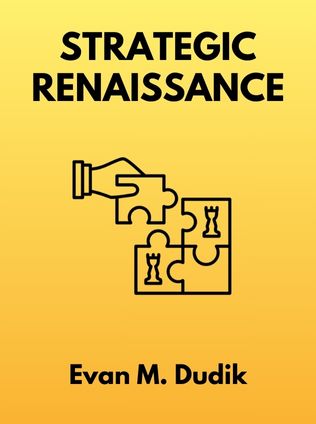
Strategic Renaissance
New Thinking and Innovative Tools to Create Great Corporate Strategies. . . Using Insights from History and Science
By Evan M. Dudik
Published 05/2000
Strategic Renaissance: New Thinking and Innovative Tools to Create Great Corporate Strategies
About the Author
Evan M. Dudik is the president of Evan M. Dudik & Associates, Inc., a management consulting firm based in Vancouver, Washington. He has also worked as a consultant for the international firm McKinsey and Company and as a lobbyist in Washington, D.C. Dudik brings a wealth of experience and innovative thinking to the table, aiming to help companies develop sophisticated and creative strategies that are rigorous and results-oriented.
Main Idea
In "Strategic Renaissance," Evan M. Dudik introduces a new approach to corporate strategy, one that departs from the traditional methods which often lead to stagnation and imitation. Dudik's methodology emphasizes the importance of creating and exploiting opportunities through a scientific yet innovative approach. By systematically developing strategies based on rigorous testing and adaptable frameworks, companies can navigate the complexities of modern markets more effectively. Dudik advocates for a shift from sustainable competitive advantage (SCA) to opportunity creation and exploitation (OCE), promoting a dynamic, flexible approach that continuously adapts to changing circumstances.
Table of Contents
- Don't Let Case Studies Decide Your Strategy
- The Four Key Elements of a Successful Strategy
- Strategic Anatomy: Strategy's Hammer and Pivot
- The End of an Era: The Twilight of Sustainable Competitive Advantage
- Making Strategy Dynamic: The Dawn of Opportunity Creation and Exploitation
- Better Tools for Better Strategies: Creating, Testing and Falsifying Strategic Ideas
- Strategic Breakthrough: Making the Right Choices and Choosing the Right Tools
- Born Allies and Sworn Enemies: Corporate Strategy Meets Corporate Culture
Don't Let Case Studies Decide Your Strategy
Many business books rely on case studies of successful companies to validate their strategic theories. However, Dudik argues that this approach is flawed. These case studies often cherry-pick examples that support the author's viewpoint while ignoring those that don't. This method of reasoning can be misleading, akin to how an astrologer might selectively present predictions that came true while disregarding the numerous failures.
Evan M. Dudik states, "The premise that examples are proof is simply wrong. There is a better way. It isn't the amount of evidence that can be marshaled to support a theory, such as examples of life happening according to horoscopes, business surging according to prescribed strategy, and weight dropping because of diet."
Instead of using examples as proof, Dudik suggests posing business strategies as falsifiable hypotheses. This means framing strategies as "if-then" statements, which can be tested and potentially disproven. This scientific approach allows companies to rigorously evaluate their strategies and adapt based on real-world results.
The Four Key Elements of a Successful Strategy
Dudik outlines four essential guidelines for developing a successful strategy:
Sign up for FREE and get access to 1,400+ books summaries.
You May Also Like
Rich Dad Poor Dad
What the Rich Teach Their Kids About Money - That the Poor and Middle Class Do Not!
By Robert T. KiyosakiFreakonomics
A Rogue Economist Explores the Hidden Side of Everything
By Steven D. Levitt and Stephen J. DubnerThe Lean Startup
How Today's Entrepreneurs Use Continuous Innovation to Create Radically Successful Businesses
By Eric RiesWho Moved My Cheese?
An Amazing Way to Deal with Change in Your Work and in Your Life
By Spencer Johnson, M.D.Factfulness
Ten Reasons We're Wrong About the World – and Why Things Are Better Than You Think
By Hans RoslingMake Your Bed
Little Things That Can Change Your Life...And Maybe the World
By William H. McRaven



















